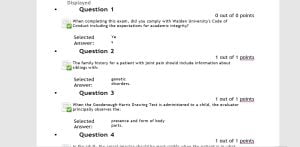COURSE
NURS 6512 Advanced Health Assessment and Diagnostic
Number of Questions: 1 – 101
Questions
- Question: When completing this exam, did you comply with Walden University’s Code of Conduct including the expectations for academic integrity?
- Question: The family history for a patient with joint pain should include information about siblings with:
- Question: When the Goodenough-Harris Drawing Test is administered to a child, the evaluator principally observes the:
- Question: In the adult, the apical impulse should be most visible when the patient is in what position?
- Question: When assessing a 17-year-old for nuchal rigidity, you gently raise his head off the examination table. He involuntarily flexes his hips and knees. To confirm your suspicions associated with this positive test, you would also perform a test for the _____ sign.
- Question: A red, hot swollen joint in a 40-year-old man should lead you to suspect:
- Question: Electrical activity recorded by the electrocardiogram (ECG) tracing that denotes the spread of the stimulus through the atria is the:
- Question: Which cranial nerves are usually evaluated during the examination of the eyes?
- Question: A pulsation that is diminished to the point of being barely palpable would be graded as:
- Question: Your 15-year-old patient is athletic and thin. Radiography of an ankle injury reveals a stress fracture. You should question this patient about her:
- Question: A positive straight leg raise test usually indicates:
- Question: A common finding in markedly obese and pregnant women is:
- Question: A patient you are seeing in the emergency department for chest pain is suspected of having a myocardial infarction. During the health history interview of his family history, he relates that his father had died of “heart trouble.” The most important follow-up question you should pose is which of the following?
- Question: A patient in the deepest coma would be scored a _____ on the Glasgow Coma Scale.
- Question: Cranial nerve XII may be assessed in an infant by:
- Question: A 23-year-old white woman has come to the clinic because she has missed two menstrual periods. She states that her breasts have enlarged and that her nipples have turned a darker color. Your further response to this finding is to:
- Question: One of the most important aspects to consider in the orthopedic screening examination is:
- Question: To spread the breast tissue evenly over the chest wall, you should ask the woman to lie supine with:
- Question: An idiopathic spasm of arterioles in the digits is termed:
- Question: If pitting edema is unilateral, you would suspect occlusion of a:
- Question: Tarry black stool should make you suspect:
- Question: A parent is advised to restrict contact or collision sports participation for their child. An example of a sport in which this child could participate is:
- Question: When is the mental status portion of the neurologic system examination performed?
- Question: The adnexa of the uterus are composed of the:
- Question: Which portion of the physical examination is best done with the patient standing?
- Question: You are examining a patient in the emergency department who has recently sustained head trauma. In order to initially assess this patient’s neurologic status, you would:
- Question: A finding that is indicative of osteoarthritis is:
- Question: Bimanual examination of the uterus includes:
- Question: At your first meeting with a patient, it is usually best to say:
- Question: Throughout the history and physical examination, the clinician should:
- Question: You are inspecting the genitalia of an uncircumcised adult male. The foreskin is tight and cannot be easily retracted. You should:
- Question: When palpating breast tissue, the examiner should use the _____ at each site.
- Question: A grade IV mitral regurgitation murmur would:
- Question: Which of the following statements is true regarding the examination of peripheral arteries?
- Question: You are examining Mr. S., a 79-year-old diabetic man complaining of claudication. Which of the following physical findings is consistent with the diagnosis of arterial occlusion?
- Question: You are interviewing a 20-year-old patient with a new-onset psychotic disorder. The patient is apathetic and has disturbed thoughts and language patterns. The nurse recognizes this behavior pattern as consistent with a diagnosis of:……..
ANSWERS

………please click the icon below to purchase full exam answers at $20